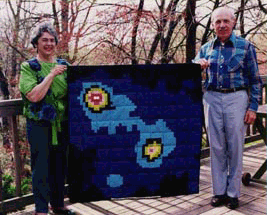Imagine the Universe News - 19 July 2000
Cuddling Up in a Quilt of Gamma-ray Stars
| 19 July 2000 |
The Compton Gamma Ray Observatory may be gone, but its memory lives on -- in a quilt museum in Harrisonburg, Virginia. Unbeknownst to Compton astronomers, a retired couple in rural Virginia took two gamma-ray images that their son received from NASA way back in 1993 and turned them into spectacular quilts.
One image, of the Crab and Geminga pulsars, is on display through September 18 at the Virginia Quilt Museum. The second, of a gamma-ray quasar called 3C 279, graced the celebratory symposium of the Compton mission on July 19 at NASA Goddard Space Flight Center in Greenbelt, MD.
"I can't say I know much about quilt-making, but these are fabulous reproductions of the original Compton images, right down to the smallest detail, or data point," said Dr. Neil Gehrels, a Goddard astrophysicist and project scientist for the mission. "We could use them as view graphs at meetings if the electricity should ever fail."
The cosmic quilt makers are Rose and Albert Costanzo, a retired couple who manage a Christmas tree farm in Elkwood, VA. In their ten years of quilting, they have never made an astronomy-themed quilt. Nor do they consider themselves amateur astronomers. Mrs. Costanzo was simply struck by the gamma-ray images that her son showed her, captured by a Compton instrument called EGRET.

|
|
Rose and Albert Costanzo display their
quilt of the Crab and Geminga pulsars based on a CGRO EGRET image. (photo credit: James Roy)
|
Mrs. Costanzo wrote to Goddard in June after hearing about the end of the Compton mission via controlled reentry over the Pacific Ocean. "I saw in the paper that their satellite was deliberately crashed in the ocean," said Mrs. Costanzo. "I just wanted them to know that one of EGRET's many images can now be seen as a quilt hanging in a museum." EGRET is short for Energetic Gamma-Ray Experiment Telescope, one of four main instruments aboard Compton. The Compton Observatory, launched in 1991, burned up in the earth's atmosphere during a controlled reentry on June 4, 2000.
Mrs. Costanzo first caught the astronomy bug when images from the Hubble Space Telescope of swirling and bulging false-colored galaxies began to appear in popular news magazines such as Time and Newsweek. Early attempts at quilting these images didn't go far.
In 1993, the Costanzos' son, Daniel, now a volunteer coordinator for the Albert Einstein Planetarium at the National Air and Space Museum, thought that new Compton images he had seen would lend themselves perfectly to a quilt design. Such gamma-ray images are blocky or pixilated, by nature of the telescope technology and the physical nature of gamma rays.
Daniel Costanzo contacted Dr. Dave Thompson, a Goddard astrophysicist who works closely with EGRET data. Dr. Thompson quickly sent off two photographs of EGRET images to Daniel, not knowing what they would be used for. That's the last that Dr. Thompson heard of the Costanzos... until June 12, 2000.
Mrs. Costanzo letter to Dr. Thompson -- written in an "FYI" manner -- contained a photograph of the Crab and Geminga quilt. The EGRET team members at Goddard were so impressed that they asked the Costanzos to join them at the Compton symposium and to bring the second quilt, not yet on display. The Goddard visitors center would also like to display both quilts. "My husband and I are completely bewildered by these snowballing events," said Mrs. Costanzo. "This is certainly exciting."
With the success of the Compton quilts, the Costanzos plan to attempt yet another celestial image, perhaps from the recently launched Chandra X-ray Observatory. Chandra has already captured hundreds of dramatic images of supernovae and flaring stars.
Rose Costanzo is a former school teacher and one of the first women to graduate from St. Bonaventure University. Albert Costanzo, a veteran of three wars, is a retired Army colonel and was a West Point classmate of Edwin "Buzz" Aldrin. Mrs. Costanzo designs and pieces together the quilts; her husband helps with the final stitching, which is called quilting.

